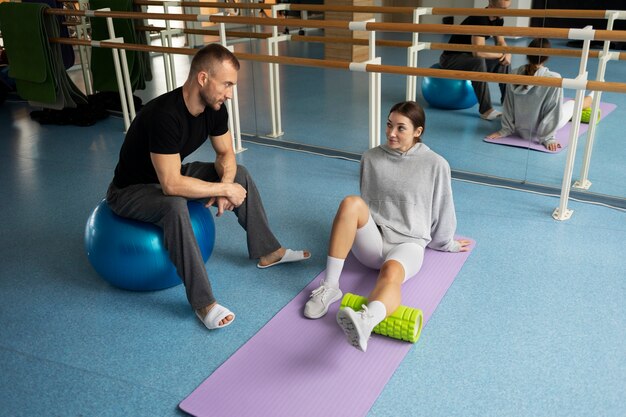When it comes to maintaining optimal health, many people focus on one-size-fits-all solutions—be it consistent exercise or medications prescribed by a healthcare specialist. But what if these approaches weren’t an either/or scenario? What if regular exercise and medical interventions could work hand in hand to amplify your overall well-being?
This Article dives into the symbiotic relationship between physical activity and medical treatments, highlighting how each complements the other to achieve better outcomes. With examples ranging from cardiovascular health to weight management, we’ll explore the essential role movement plays in partnership with treatments like medications and therapies.
The Holistic Value of Exercise and Medical Care
Medical interventions, such as prescription medications or surgical treatments, are often necessary for managing chronic conditions and addressing acute issues. Similarly, regular exercise is lauded for its ability to improve physical strength, cardiovascular efficiency, mental health, and flexibility. When blended thoughtfully, these two practices can elevate the effectiveness of each other.
Key Benefits Include:
Improved medication efficacy through better blood circulation.
Enhanced mental health and stress management, aiding the recovery process.
A lowered risk of treatment-associated side effects, such as weight gain or muscle loss.
By integrating exercise into treatment plans, healthcare practitioners can offer patients a more comprehensive and sustainable solution for long-term health.
Enhancing Cardiovascular Treatments Through Exercise
Heart disease remains one of the leading causes of mortality worldwide, and medications like statins or beta-blockers have been key to managing this condition. However, research demonstrates that regular aerobic activity magnifies the positive outcomes of medical intervention, ranging from lowered cholesterol to stabilized blood pressure.
For instance, a 30-minute brisk walk 5 times a week complements the effects of hypertensive medications, ensuring that blood vessels stay elastic and healthy. Similarly, resistance training may help reduce triglycerides when paired with specific lipid-lowering drugs.
Pro Tip for a Heart-Healthy Combination:
Speak to your doctor about a safe exercise regimen that aligns with your cardiovascular medications. Monitoring heart rate and blood pressure during workouts is important for those treating heart disease.
Synergy Between Exercise and Weight Loss Medications
In Salt Lake City, prescription medications like semaglutide are gaining popularity for assisting individuals in achieving sustainable weight loss. Semaglutide, for example, works by regulating blood sugar levels and suppressing appetite. When complemented by regular physical activity, the results can be even more pronounced.
Exercise helps by building lean muscle mass, which increases resting metabolism and creates better insulin sensitivity—essential factors for anyone managing weight or metabolic conditions. Additionally, activities like biking or swimming can inspire greater motivation to adhere to nutritional and medical plans.
Popular Weight-Friendly Workouts:
High-Intensity Interval Training (HIIT) for efficient calorie burn.
Yoga to enhance flexibility and reduce stress, which could otherwise trigger overeating.
Strength training for boosting endurance and metabolism.
Exploring Emotional Health with Mind-Body Connections
While much focus is placed on physical health, emotional well-being is equally critical when considering medical interventions. For patients dealing with depression or anxiety, psychotherapy and medications remain invaluable tools. Nevertheless, the endorphin-releasing benefits of exercise play a crucial role in complementing emotional health treatments.
Studies reveal that regular workouts, particularly aerobic activities, have a unique ability to mimic the impact of antidepressants by enhancing serotonin and dopamine production. Pairing cognitive behavioral therapy with light jogging or pilates sessions often yields improved outcomes, fostering resilience while reducing dependencies on higher medication dosages.
Suggestions for Mind-Body Synergy:
Meditative Runs – Combine jogging with mindfulness techniques like deep breathing.
Tai Chi or Qigong – Known for their stress-relieving properties.
Group Fitness Classes – Foster social interactions to further lift spirits.
Boosting Recovery and Rehabilitation Programs
For patients recovering from surgery, injury, or long-term illnesses, physical therapy plays an instrumental role in regaining function. However, incorporating exercise beyond the confines of prescribed therapy can bolster rehabilitation efforts. For instance:
Light stretching and yoga aid in improving joint mobility post-orthopedic surgery.
Low-impact aquatic exercises like hydrotherapy support recovery while reducing pressure on healing bones or tissues.
Regular exercise under appropriate guidance helps boost blood flow, enabling faster delivery of nutrients critical to recovery. Furthermore, it prevents muscle atrophy—a common risk for individuals undergoing extended bedrest or recovery phases.
The Role of a Fitness Plan in Chronic Disease Management
Exercise also plays a powerful complementary role in the treatment of chronic diseases such as diabetes, arthritis, and asthma. For example:
Diabetes: Physical activity keeps blood sugar levels in check by improving insulin sensitivity. Diabetics taking medications like metformin are more likely to enjoy better outcomes if they participate in resistance training or moderate aerobic activities.
Arthritis: Strengthening exercises provide pain relief and improve joint function, complementing anti-inflammatory treatments.
Asthma: These patients benefit from cardiovascular workouts that enhance respiratory efficiency and reduce reliance on bronchodilators.
The key lies in finding personalized regimens that allow sustainable progress without overexertion.
Putting It All Together
Modern medicine offers extraordinary tools to manage health. However, integrating regular physical activity into your health routine transforms passive treatments into active partnerships. Whether enhancing the effects of cardiovascular medications, boosting weight loss results, or speeding up injury recovery, exercise is a universal catalyst for better outcomes.
It’s important to work closely with healthcare providers before initiating a fitness program tailored to your condition and treatment plan. Together, they’ll help boost fitness potential while ensuring safety across every step of the process.








Leave a Reply